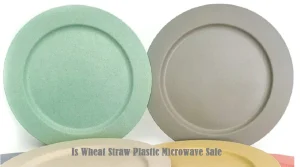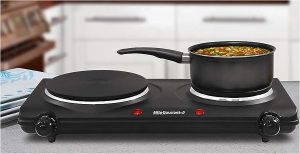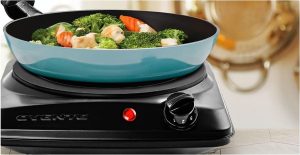Bamboo Vs. Stainless Steel Steamer: When Which is Better?
Note: This article may contain affiliate links, which means if you make a purchase following our links won’t cost you extra, but we may earn a commission. Learn more
Choosing between a bamboo and a stainless steel steamer can be a pivotal decision in your culinary journey. Both have their unique attributes and are suited to different cooking styles and preferences.
A bamboo steamer, with its traditional charm, is ideal for those who value authenticity and gentle cooking. It retains moisture, nutrients, and flavor, making it perfect for steaming dumplings, fish, and vegetables.
On the other hand, a stainless steel steamer offers durability and versatility. It’s a robust choice for the modern kitchen, compatible with various heat sources, and dishwasher safe. This metal steamer can withstand high temperatures and is excellent for a wide range of foods.
In the bamboo vs stainless steel steamer debate, your choice hinges on your cooking style, maintenance preference, and the type of food you frequently prepare. Whether it’s a stainless steel steamer or a bamboo steamer basket, each has its unique appeal and functionality.
The bamboo steamer vs regular steamer comparison often boils down to tradition versus modernity, and the choice is yours to make.
Related: 6 Best Stainless Steel Steamer Pots
bamboo vs stainless steel steamer: Key Features Comparison
Material and Durability
Bamboo steamers, made from natural bamboo, offer a traditional and eco-friendly option. They are lightweight and have a unique ability to absorb excess steam, preventing water droplets from falling onto the food.
Stainless steel steamers, on the other hand, are known for their robustness and longevity. They can withstand high temperatures and are resistant to rust and corrosion, making them a durable choice for regular use.
Cooking Performance
Bamboo steamers are excellent at retaining moisture, nutrients, and flavor of the food, making them ideal for steaming dumplings, fish, and vegetables. They also add a subtle bamboo aroma to the dishes.
Stainless steel steamers are versatile and can handle a wide range of foods. They heat up quickly and evenly, ensuring efficient cooking.
Maintenance and Cleaning
Bamboo steamers require careful cleaning and drying to prevent mold and mildew. They are not dishwasher safe and need to be hand-washed.
Stainless steel steamers are easy to clean and maintain. They are dishwasher safe, which makes cleaning up after cooking a breeze.
Versatility and Use
Bamboo steamers are typically used for Asian-style cooking and are perfect for those who value authenticity in their culinary experiences.
Stainless steel steamers offer more versatility. They can be used on various heat sources and are suitable for a wide range of cooking styles.
Heat Retention and Distribution
Bamboo steamers are good at retaining heat but may not distribute it as evenly as their metal counterparts.
Stainless steel steamers excel in heat distribution, ensuring that food is cooked evenly and thoroughly.
Learn More: 4 Best Crab Steaming Pots for Flavorful Crabs
Bamboo Steamer Reviews (Joyce Chen Steamer, Bamboo)
The Joyce Chen Bamboo Steamer is a culinary gem that brings the time-tested method of bamboo steaming into your kitchen.
This medium-sized steamer is perfect for creating restaurant-style dishes at home, including dumplings, veggies, and fish. With two tiers, you can cook several dishes or servings simultaneously, maximizing efficiency. The simplicity of use is another appealing feature; just place it in a pan of water and heat.
Crafted from traditional bamboo, a renewable resource, this steamer is as eco-friendly as it is functional. Its dimensions of 10.00 in L x 10.00 in W x 6.00 in H make it a compact yet capable addition to your kitchen.
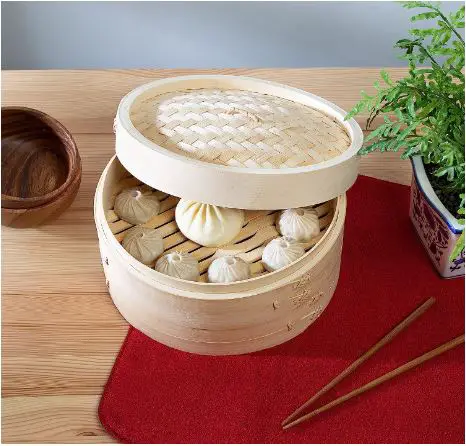
Highlighted Features
- Time-tested bamboo steaming method
- Two-tier design for multi-dish cooking
- Simple to use and clean
- Made from renewable bamboo
- Compact and functional design
Compatible For
- Steaming dumplings, veggies, and fish
- Multi-dish cooking
- Small to medium-sized kitchens
Where Need to Improve
- Not dishwasher safe
- Bamboo may absorb food odors
Stainless Steel Steamer Reviews (Concord 30 CM Stainless Steel 3 Tier Steamer Pot)
The Concord 30 CM Stainless Steel 3-Tier Steamer Pot is a versatile and robust addition to any kitchen. Made of fully polished stainless steel, this steamer pot includes 2 interchangeable steamer trays/baskets, one with smaller holes for rice, momos, etc., and one with regular holes for buns, vegetables, and fish.
The steamer can be used as 3 different pots, making it a versatile choice for various cooking needs. The stay-cool handles and heavy triply bottom ensure safety and durability.
With measurements of 12.5″ Width x 9.75″ Height, this large steamer is great for 3-4 persons.
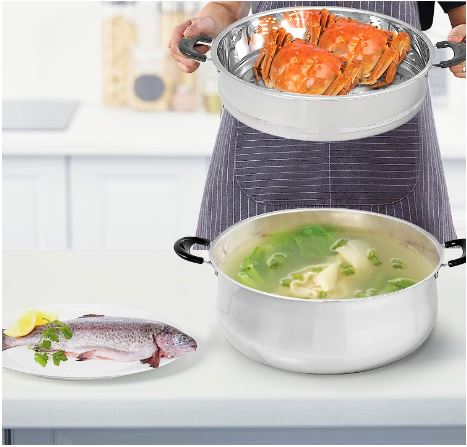
Highlighted Features
- Fully polished stainless steel construction
- Includes 2 interchangeable steamer trays
- Versatile 3-in-1 pot design
- Stay-cool handles and heavy triply bottom
- Large capacity for multiple servings
Compatible For
- Steaming rice, momos, buns, vegetables, and fish
- Multi-level cooking
- Large family meals
Where Need to Improve
- May be too large for small kitchens
- Not suitable for induction cooktops
what to use a bamboo steamer for
Bamboo steamers are a staple in Asian cuisine, known for their ability to retain the food’s natural flavors, nutrients, and moisture. They are ideal for steaming a variety of foods.
1. Dumplings, a classic dish in Asian cuisine, are often cooked in bamboo steamers, as the bamboo absorbs excess moisture, preventing the dumplings from becoming soggy.
2. Vegetables can also be steamed to perfection in a bamboo steamer, retaining their vibrant colors and crisp texture.
3. Fish, too, benefits from the gentle steaming process, maintaining its delicate flavor and texture.
4. Bamboo steamers can also be used for cooking rice, buns, and even certain desserts. The subtle bamboo aroma that infuses into the food is an added bonus, enhancing the overall culinary experience.
what to use a stainless steel steamer for
Stainless steel steamers are a versatile tool in the kitchen, capable of cooking a wide range of foods.
1. They are excellent for steaming vegetables, as the quick and even heat distribution ensures the vegetables are cooked evenly while retaining their nutrients.
2. Seafood, such as fish and shellfish, can be steamed to perfection in a stainless steel steamer, with the high heat ensuring a quick cooking time.
3. Rice and grains can also be cooked in a stainless steel steamer, with even heat distribution ensuring every grain is perfectly cooked.
4. Stainless steel steamers are also suitable for cooking meat, poultry, and even certain types of bread. Their robust construction and high heat resistance make them a reliable choice for various cooking tasks.
how to use bamboo teamers basket
Using a bamboo steamer basket is a simple yet effective way to cook food. Start by lining the bottom of the steamer with lettuce leaves or parchment paper to prevent the food from sticking.
Arrange the food in a single layer, ensuring there is space between each piece to allow the steam to circulate. Place the bamboo steamer in a wok or a pan with simmering water. The water level should be below the steamer to prevent the water from touching the food.
Cover the steamer and allow the food to cook for the required time. Remember to check the water level periodically and add more if necessary.
Once the food is cooked, remove the steamer from the heat and let it sit for a few minutes before opening to avoid steam burns.
how to use stainless steel steamer
Operating a stainless steel steamer is straightforward and efficient. Fill the bottom pot with water, ensuring the water level is below the steamer basket. Place the food in the steamer basket, arranging it in a single layer for even cooking.
Position the steamer basket on top of the pot and cover it with a lid. Heat the pot on the stove until the water boils. The steam produced will cook the food. Monitor the cooking process and adjust the heat as necessary to maintain steady steam.
Once the food is cooked, turn off the heat and carefully remove the steamer basket using oven mitts or tongs to prevent burns.
Bamboo vs Stainless Steel Steamer: The Choosing Factors
In the culinary world, the choice between bamboo and stainless steel steamers often hinges on several key factors.
Material properties play a significant role. Bamboo, a natural and porous material, absorbs moisture during the steaming process, preventing water droplets from falling onto the food. This results in a unique flavor and texture that is hard to replicate with other materials.
On the other hand, stainless steel, being non-porous and durable, offers longevity and consistent performance.
The type of cuisine you frequently prepare can also influence your choice. Bamboo steamers are traditionally used in Asian cuisine, particularly for dumplings and buns, while stainless steel steamers are versatile and can be used for a variety of dishes, including vegetables, seafood, and meat.
Ease of use is another factor. Stainless steel steamers often come with multiple tiers and a lid, making it easy to steam different foods simultaneously. Bamboo steamers, while they can also have multiple tiers, require a wok or a similar pan for proper use.
Aesthetics can also sway your decision. Bamboo steamers have a rustic, traditional appeal, while stainless steel steamers offer a sleek, modern look.
Bamboo vs Stainless Steel Steamer: Cleaning and Maintenance
The cleaning and maintenance of your steamer can significantly impact its lifespan and performance. Bamboo steamers require careful cleaning due to their porous nature. It’s best to hand wash them with warm water and a soft brush, then air dry thoroughly to prevent mold growth. Using detergents or dishwashers can damage the bamboo and shorten its lifespan.
Stainless steel steamers, on the contrary, are much easier to clean. They are dishwasher-safe and resistant to rust and stains. You can also use mild detergents without worrying about damaging the material.
Maintenance-wise, bamboo steamers need regular checks for mold, especially if they are not used frequently. They also need to be replaced more often than their stainless steel counterparts due to wear and tear.
Stainless steel steamers require minimal maintenance. They are highly durable and can withstand high heat and heavy use. Regular cleaning is usually enough to keep them in good condition for years.
Frequently Asked Questions
What are the main differences between bamboo and stainless steel steamers?
Bamboo steamers are traditional Chinese cooking tools made from interlocking bamboo trays. They are eco-friendly, absorb excess moisture, and add a subtle flavor to the food. Stainless steel steamers, on the other hand, are modern, durable, and easy to clean. They don’t absorb flavors or odors, making them versatile for different types of food.
Which one is more durable, bamboo or stainless steel steamer?
Stainless steel steamers are generally more durable than bamboo ones. They are resistant to rust, scratches, and dents, and can withstand high heat and heavy use. Bamboo steamers, while sturdy, can wear out over time and require more careful handling to prevent damage.
Is there a taste difference when using bamboo vs stainless steel steamers?
Yes, there can be a subtle taste difference. Bamboo steamers are known to impart a mild, earthy flavor to the food, enhancing the overall taste. Stainless steel steamers, being non-reactive, do not add any flavor to the food, preserving the original taste.
Which one is easier to clean, bamboo or stainless steel steamer?
Stainless steel steamers are easier to clean as they are dishwasher safe and do not absorb food odors or stains. Bamboo steamers, however, need to be hand-washed and air-dried, and they can absorb flavors and colors from the food.
Are there any specific foods that are better suited for bamboo or stainless steel steamers?
Bamboo steamers are ideal for steaming dumplings, buns, and other Asian cuisine, as they enhance the flavor. Stainless steel steamers are more versatile and can be used for a variety of foods, including vegetables, seafood, and meat, without altering their taste.
What are the price differences between bamboo and stainless steel steamers?
Bamboo steamers are generally cheaper than stainless steel ones. Considering the durability and ease of maintenance, a stainless steel steamer may offer better long-term value.
Can I use metal utensils with bamboo and stainless steel steamers?
While you can use metal utensils with stainless steel steamers without causing damage, it’s recommended to use wooden or silicone utensils with bamboo steamers to prevent scratching or damaging the bamboo.
Featured Image Credit: Amazon.com


